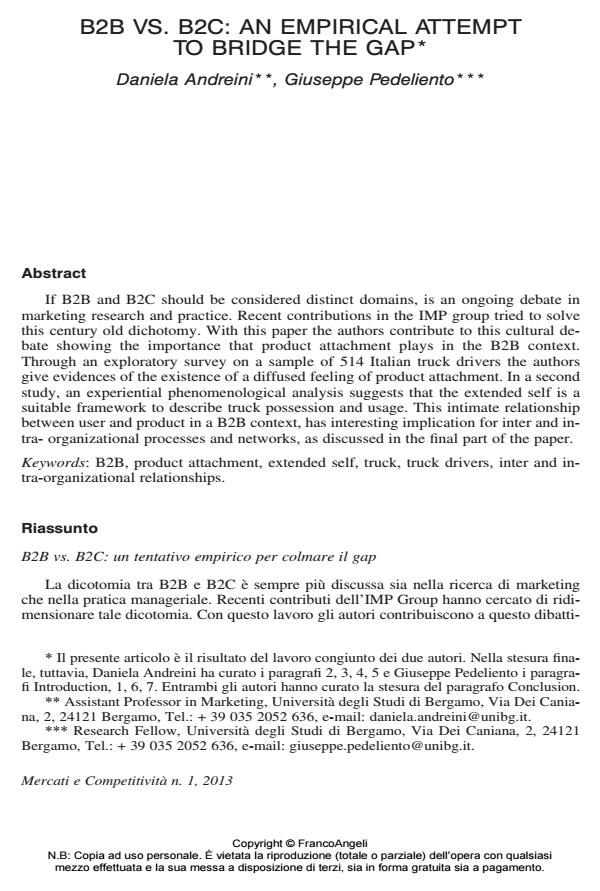B2B vs. B2C: an empirical attempt to bridge the gap
Titolo Rivista MERCATI E COMPETITIVITÀ
Autori/Curatori Daniela Andreini, Giuseppe Pedeliento
Anno di pubblicazione 2013 Fascicolo 2013/1
Lingua Inglese Numero pagine 24 P. 73-96 Dimensione file 520 KB
DOI 10.3280/MC2013-001006
Il DOI è il codice a barre della proprietà intellettuale: per saperne di più
clicca qui
Qui sotto puoi vedere in anteprima la prima pagina di questo articolo.
Se questo articolo ti interessa, lo puoi acquistare (e scaricare in formato pdf) seguendo le facili indicazioni per acquistare il download credit. Acquista Download Credits per scaricare questo Articolo in formato PDF

FrancoAngeli è membro della Publishers International Linking Association, Inc (PILA)associazione indipendente e non profit per facilitare (attraverso i servizi tecnologici implementati da CrossRef.org) l’accesso degli studiosi ai contenuti digitali nelle pubblicazioni professionali e scientifiche
If B2B and B2C should be considered distinct domains, is an ongoing debate in marketing research and practice. Recent contributions in the IMP group tried to solve this century old dichotomy. With this paper the authors contribute to this cultural debate showing the importance that product attachment plays in the B2B context. Through an exploratory survey on a sample of 514 Italian truck drivers the authors give evidences of the existence of a diffused feeling of product attachment. In a second study, an experiential phenomenological analysis suggests that the extended self is a suitable framework to describe truck possession and usage. This intimate relationship between user and product in a B2B context, has interesting implication for inter and intra- organizational processes and networks, as discussed in the final part of the paper.
La dicotomia tra B2B e B2C è sempre più discussa sia nella ricerca di marketing che nella pratica manageriale. Recenti contributi dell’IMP Group hanno cercato di ridimensionare tale dicotomia. Con questo lavoro gli autori contribuiscono a questo dibatti- to dimostrando quanto l’affezione al prodotto giochi un ruolo primario anche in contesti industriali. Attraverso un’indagine esplorativa su un campione di 514 camionisti italiani, gli autori dimostrano l’esistenza di un diffuso senso di affezione al mezzo. Un secondo studio qualitativo indaga il possesso e l’utilizzo del camion attraverso il metodo della fenomenologia esperienziale. Questa intima relazione tra utilizzatore e prodotto in un contesto B2B ha interessanti implicazioni sui processi interni delle organizzazioni e sui loro rispettivi network esterni, come discusso nella parte finale di questo articolo.
Parole chiave:B2B, attaccamento al prodotto, estensione del sé, camion, camionista, relazioni organizzative interne ed esterne
- Analyzing Attachment and Consumers' Emotions pp.172 (ISBN:9781522549840)
Daniela Andreini, Giuseppe Pedeliento, B2B vs. B2C: an empirical attempt to bridge the gap in "MERCATI E COMPETITIVITÀ" 1/2013, pp 73-96, DOI: 10.3280/MC2013-001006